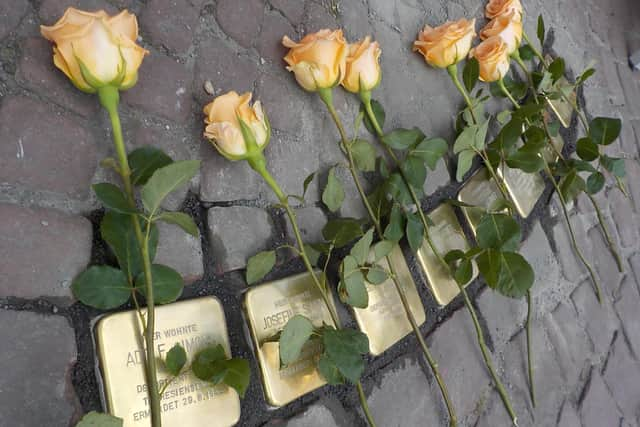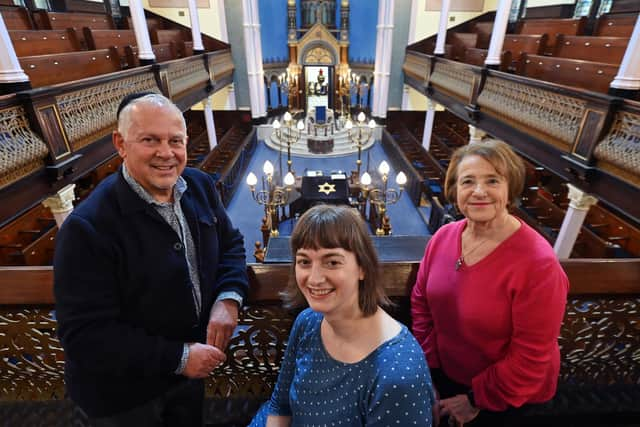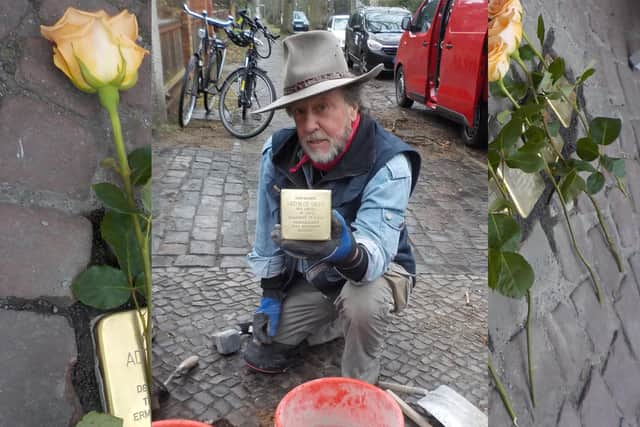‘Their stories must not be lost’ - remembering the names, lives, and contributions of those persecuted by the Nazi Holocaust
The stones stuck with me and returning to my hometown for brief visits after I moved away, I saw more of them pop up, each bearing a new name and brief history. One appeared beside the pool in which I learned to swim, another near my friend’s house in the town centre. Yet, it was only this year, I learned these small stones - each only measuring 10x10cm - were part of the largest decentralised Holocaust memorial in the world.
The individual stones are referred to as STOLPERSTEIN, literally translated to “stumbling stone”, and are part of the STOLPERSTEINE project by German artist Gunter Demnig. The project started small – first only existing as a form of concept art with one-off placements in Cologne and Berlin in 1992 and 1996. In the 30 years since, more than 90,000 stones have been placed across Europe, and even as far as South America.
Advertisement
Hide AdAdvertisement
Hide Ad“The basic idea was to put a stone reminding of the Himmler order, which Himmler supposedly never gave - despite administrative documents existing for it,” Demnig explains. “It's one sentence: ‘The gipsies, off to Auschwitz.’ That was quite simply the death sentence for the Roma and Sinti. In autumn 1992, 50 years later I - somewhat illegally - placed it [a stone] in front of Cologne City Hall. That’s where the idea of the STOLPERSTEINE came from. To bring back the names; to bring back the individual people.”


STOLPERSTEINE are placed for people who were persecuted during the Nazi era: Jews; Roma and Sinti; mentally and/or physically disabled people; other people persecuted for their political views, their religion, their sexual orientation, or the colour of their skin; people considered deserters; homeless people; sex workers; and more. They are also placed for survivors and those displaced. Always following the same concept: one name, one stone; placed at the last known, self-chosen address of those commemorated.
“The basic concept was everywhere in Germany or in Europe where the German Wehrmacht, the SS, the Gestapo, did their bidding. However, Spain, for example, was added because it's two-fold. Without the German Wehrmacht, Franco would never have come to Spain; never been able to win. When it comes to the UK, it's a place where people have found refuge.
“I've had family reunions from three continents and five countries. One of the most extreme cases happened in Rotenburg an der Wümme, near Bremen, in 2004. The parents were murdered in Auschwitz. The two daughters were rescued via Kindertransport. For the laying, the two sisters arrived. One from Colombia, the other from the UK. Before that, they hadn't seen each other for 60 years. One of them said: ‘Now we’re together with our parents again.’ It’s then I know why I do this.”
In German, the word Stolperstein has multiple functions. It describes the stones laid by Demnig which – although not raised enough to physically make anyone stumble – visibly stick out of the pavement in which they are placed; drawing in the attention of passers-by that stumble upon them. Yet, more commonly, it is known and used as a metaphor. What is meant is not an actual physical stumble, but a symbolic, inner stumble; triggered by a thought-provoking impulse or event.


“For me, it is most important that we reach the youth. Initially, I was warned by teachers who told me: ‘Don’t bring up this subject. It's coming out of their ears.’ I've simply had other experiences. I think there is a difference between opening a book and reading about six million murdered Jews in Europe, and another eight million murdered for other reasons. That's something abstract.
“When they suddenly realise ‘that was just around the corner from us’ and ‘their children went to our school, or ‘they were the same age as we are now’. Suddenly, that becomes tangible - especially when relatives come along, contacts are made, and conversations are held.
“These things are very important to me. The pupils are taking a lot in and with them. Often the principal question or fact is: ‘How could something like this happen in the country of poets and thinkers?’ The conclusion always is: something like this must never happen again.”
*****


Advertisement
Hide AdAdvertisement
Hide AdThis year’s Holocaust Memorial Day theme was “One Day.” It is said that many survivors often quote “one day” when everything changed. For many, one such day was when they started life in a new country. After the rise in violent attacks such as Kristallnacht in 1938, the UK Government, supported by local communities and their fundraising efforts, arranged for 10,000 unaccompanied children to come to the UK. Others came through different ways such as Domestic Service Visas. Many came to Scotland, becoming part of the communities that welcomed them.
One such community was Glasgow’s Garnethill. Tucked away atop the steep hill of Garnet Street and the corner of Hill Street, is Garnethill Synagogue – Scotland’s first purpose-built synagogue opened in 1879. It is home to the Scottish Jewish Heritage Centre and the Scottish Jewish Archives Centre, a charity documenting the experiences of Jewish people in Scotland, dating back over 200 years. Most recently, the building has become the starting point of the Garnethill Heritage Trail. “Garnethill has a lot of Jewish heritage that we would like to make people aware of,” Kerry Patterson, Manager of the Scottish Jewish Heritage Centre, says.
The trail covers both well-known places, such as The Glasgow School of Art, as well as places lost, such as the Refugee Club – a place for refugees to socialise with one another and meet Scots - which is now the Glasgow Dental Hospital. Each location had significance in shaping and now re-telling the stories of refugees that came to Glasgow before, during, and after the Second World War. They are also a reminder of how refugees shaped the local Garnethill community we see today.
“I think these materials are always fascinating. To bring into focus history that's in your own area,” Patterson explains. “It's still something that happens; cohort diversity being enriched by the different cultures and people that have come here. People have come from different places. I think that's really important to understand better.
“Maybe it helps people - children, for example - to feel a sense of belonging as well, and that their history is just as valid, even if they don't have great grandparents that come from this country. That they can go do all of the things that some of these children that came over as refugees did. There's such a diversity of stories.”
The Heritage Centre hosts school visits and a weekly guided tour service. Trevor Schuster-Davis and Sandra Silverdale have both been congregation members most of their lives and are part of the team of volunteers leading tours. They tell me about times it was hard to get a seat during services; the prayer hall was so full. “I remember the people that used to sit here,” Sandra tells me as we stand in the upper-level of the hall containing the ladies’ gallery and choir stall.
The whole synagogue is full of memories. There’s a timeline of the synagogue’s history; plaques commemorate those that fought in World War I, or those members of the congregation who passed away. Outside the prayer hall is a sculpture by artist Lyn Wolfson, remembering the Kindertransport. Both Trevor and Sandra frequently point out family members, friends, and relatives in pictures, books, and plaques.
“They're the people who are responsible for you being here. They are your parents; your family. They are your friends; people you knew. You don't want them ever to be forgotten,” Sandra explains when we talk about the importance of remembrance. “You remember them in your hearts, and you remember them by talking about them. I think, with the Holocaust, it's more that there aren’t all these people left to remember them. That's why not forgetting that kind of thing is important.”
Advertisement
Hide AdAdvertisement
Hide AdFor Trevor, remembering is part of Jewish culture. “Jewish people have got a tradition of remembrance. Every festival that we have is remembrance of an event or a past and every death in a family is remembered every year. Something like the Holocaust is something that has to be remembered as part of a Jewish heritage, as part of the tradition of what we've all been brought up with; as part of our fabric, if you like. It's an element of who we've all been.”
Sandra and Trevor are both worried about the fact that other holocausts have happened since and evidence of genocide is still visible in societies. “Things that are going on just now are really awful,” Sandra explains. “I sometimes feel that although the world learned something about the Holocaust, maybe we didn't learn enough. Remembrance is one thing, taking action is another. It should never happen again. It should never happen again to anybody.
“It's the second generation that need to remember. Because the people in the first generation, they're dying out. They have lived successful lives. A lot of them have become very happy, but they're not going to be here forever and their stories must not be lost.”
“What we can remember about them is the contribution they've made to life and not just Glasgow, but in Scotland and, in fact, the whole world,” Trevor adds. “These people's lives would have been lost and it's just wonderful that they were able to give that contribution.”
****
During Holocaust Memorial Day (27 January), testimony of those with lived experience is often at the forefront of conversations. Yet, as the volunteers who set up the Gathering the Voices Association have discovered, those people also often did not get to tell their full story or did not want to be remembered solely as victims.
“People said they felt people always want to know what happened to them, where they came from, what happened to other members of the family, but didn't really ask about what they did when they came to Scotland - and they had contributed immensely,” Angela Shapiro, one of the association’s six volunteer trustees, says.
Gathering the Voices has been in existence since 2009 and is run entirely by volunteers. Since then, they have conducted more than 50 interviews with refugees from the Holocaust – many, but not all, Jewish - who came to settle in Scotland. Those interviewed have full control of their stories before, during, and after publication and interviews can be accessed freely by anyone via the association’s website. The process ensures stories are told exactly as those interviewed intend, as well as preventing survivors from having to repeatedly recall past traumatic events.
“That’s why we did it. They don't have to keep retelling their stories and reliving what happened to their families,” Shapiro explains. “For many of them, they didn't know what happened to their parents until the letters stopped.
Advertisement
Hide AdAdvertisement
Hide Ad“We've shown people as individuals and ordinary people. One of the messages we're trying to get over is that this could happen to anybody. A lot of it is luck on where you are born. It's to hopefully get rid of the stereotyping as well. That's an important part of it. Listening to different stories and different experiences.”
Education and sparking conversations is a core aspect of Gathering the Voices. The association has a mobile exhibition, regularly goes into schools, and has worked with other organisations such as Sense over Sectarianism and Education Scotland.
Hilary and Steven Anson are two of the other volunteer trustees. They describe that part of the reasons for asking survivors “What did you do for Scotland? What did Scotland do for you?” was the rising anti-refugee sentiments visible in society.
“We felt this is particularly relevant, because there was so much negativity in the media regarding refugees - you know, taking this, taking that,” Steven says. “People we were interviewing would say: ‘Refugees contribute, and there's not enough positive publicity about it.”
Steven’s parents, Martin and Pat Anson – who both escaped from Germany as the Nazi persecution of Jews increased - shared their testimonials via Gathering the Voices. Aside from the work they do in Scotland, Steven and Hilary have visited Germany, supporting initiatives commemorating their relatives, and giving talks to pupils there. A street in the German city of Augsburg was recently renamed after Steven’s mother’s family, members of which were killed by the Nazi regime.
“We know the fate that befell our parents, our family, other Jews, and of course, people from other demographics as well,” Steven says. “We're looking to educate people so that the fate that befell these people is remembered and isn't repeated.”
“History repeats itself, repeats itself, repeats itself,” Hilary adds. “You’ve got to stop it repeating itself. That's what one of the survivors said to me. You've got to keep the stories out there.” She then talks about the 10 stages of genocide: classification, symbolisation, discrimination, dehumanisation, organisation, polarisation, preparation, persecution, extermination, and then denial.
“You see it happening over and over again. You see it happening in every country actually,” Hilary says. “See what - discrimination?” Steven asks. “And does discrimination then lead to genocide?”
Advertisement
Hide AdAdvertisement
Hide AdThey both answer, almost in tandem: “No, but it depends. It can.”
****
Despite having to postpone some international trips due to Covid, Demnig is continuing his work in Germany and hopes that STOLPERSTEINE keeps bringing relatives of those remembered a form of happiness. “The term happiness is of course a double-edged sword because at first, they feel sad,” he says. “But when they see how many people - especially young people - get involved, then they go home with a different image of Germany.”
He also hopes young people will keep getting involved: “I work a lot with schools against racism and towards supporting democracy. They are engaged and want to change something and want to know what happened.”
According to Demnig, one of the most beautiful definitions of the wider meaning of STOLPERSTEINE was given by a secondary school student: “He was interviewed. A reporter asked him: ‘Listen, Stolpersteine - isn't that dangerous? Someone could fall.’
The student said: ‘No, you don't fall. You trip up with your head and with your heart.’”
---
For more information:
Holocaust Memorial Day Trust: https://www.hmd.org.uk
Scottish Jewish Heritage Centre: https://sjhc.org.uk
Gathering The Voices: https://gatheringthevoices.com
STOLPERSTEINE: http://www.stolpersteine.eu
Comments
Want to join the conversation? Please or to comment on this article.